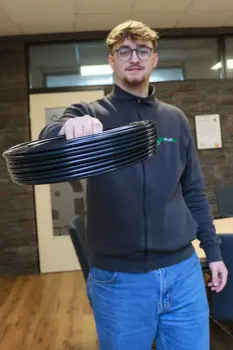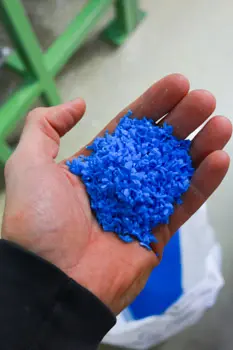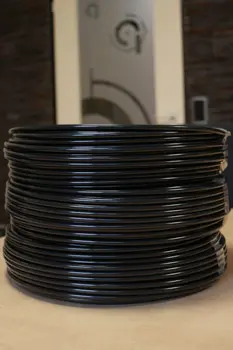
PAPUREX began recycling the unavoidable waste from polyurethane tubing production back in 2021. This waste is unavoidable because certain corrective measures must first be taken when starting up the machines until the tubing is within the tolerances agreed with the customers. Anything that comes out of the extruder before this point cannot be sold. However, this daily waste from extrusion was already being recycled long before in-house regranulation began, only externally.
However, the most efficient way to recycle is to reuse the waste where it is produced. This process has now reached its next milestone with the extrusion of the first granulated tubing made from 100% recycled waste – the first regranulated tubing from PAPUREX. This article explains why this is so special:
The difference between regranulate and recycled granulate
There are many different definitions in the field of recycling. In general, recycling refers to the process of reprocessing a material that was previously declared as waste and reusing it for a new product. So, for example, reusing a shipping box instead of throwing it away is not recycling. If all the criteria for recycling are met (waste and new product), a further distinction must be made between post-industrial and post-consumer recycling:
- Post-industrial recycling: In this form of recycling, production waste is collected, reprocessed, and returned to production. What is special about this is that the waste product never served its original purpose. Regranulation at PAPUREX is therefore a classic example of post-industrial recycling.
- Post-consumer recycling: This form of recycling refers to the process of reprocessing waste that was previously in the hands of the end consumer and using it for new products. The shredding, melting down, and reuse of PET bottles is an everyday example of post-consumer recycling.

In the public and legal perception, however, in many cases, only the second form, i.e., post-consumer recycling, is recognized as “genuine” recycling. To avoid confusion, the process at PAPUREX is deliberately not referred to as recycling, but as regranulation. The resulting regrind is accordingly called regranulate. As a logical consequence, the tubing made from 100% regranulate is not called a recycled tubing, but a regranulated tubing. This distinction in terminology is intended to avoid the misunderstanding that potential customers and other interested parties might think that this is post-consumer recycling, i.e., the recovery and processing of used tubing.
What are the environmental benefits of regranulated tubing?
Polyurethane, the raw material used in PAPUREX pneumatic tubing, is produced using gas. Conventional manufacturing methods, which will still be predominant in 2025, generate a significant amount of CO₂. Depending on the manufacturer and type of polyurethane, this amounts to between three and five kilograms of CO₂ per kilogram of raw material produced. It is therefore no surprise that material procurement accounts for by far the largest share of PAPUREX’s carbon footprint. Detailed information on this topic can be found in the current edition of PAPUREX’s environmental statement.
PAPUREX processes hundreds of tons of polyurethane. This also produces several tons of unavoidable waste, as mentioned at the beginning of this article. Through the regranulation process, this waste is reused, which in turn leads to significant savings in CO₂ emissions. Each ton of regranulate saves several tons of CO₂ that would be generated in the production of new material. This makes regranulated tubing particularly valuable from an environmental perspective.
In addition to the advantage in terms of emissions, regranulation also offers advantages in the area of waste disposal. Although plastic waste was previously recycled by external service providers, in-house use is by far the most valuable method. On the one hand, this is because it eliminates the need for further transport, which in turn can lead to emissions. On the other hand, it completely eliminates the possibility of the waste ending up in landfills and, in the worst case, in the environment.
The production of regranulated tubing is not a sure-fire success

Attentive readers of this article may already have wondered how it is possible that regranulation at PAPUREX began in 2021, but the first regranulated tubing was not extruded until 2025. This can be explained by the fact that production with regranulate differs significantly from production with new material. The fact that the recycled polyurethane has already been melted down and passed through the extruder changes its material properties. As a result, completely different production parameters (temperatures, speeds, etc.) must be applied during re-extrusion. This makes the production of pure regranulated tubing extremely challenging.
Until now, the regranulate has therefore been mixed in proportion with new material in the production of the tubing. By mixing it in, the production parameters are much closer to those of conventional extrusion. Who might be interested in the regranulated tubing?
So far, the regranulated tubing is only an experiment. It has been shown that regranulate can be used not only in proportion, but also entirely for the extrusion of high-quality polyurethane tubing. Now it is time to arouse customer interest in this type of tubing. Larger-scale use in industry would definitely save tons of CO2 and ensure the avoidance of waste.
Are you interested in tackling this sustainability project together with PAPUREX and using regranulated tubing? Contact us, and our team of experts will be happy to advise you!
